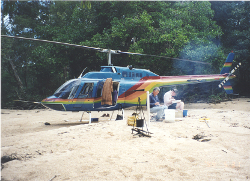|
|
Invertebrates and wetland monitoringMany invertebrates have different sensitivities to pollution and for that reason are popular indicators in wetland assessments. They respond to many kinds of changes in water quality or to physical disturbance to the wetland structure, hydrology or the landscape around the site[2]. Quick facts
Invertebrates are good indicators of condition in stream systems and can be used effectively as indicators of health and condition in natural, man made and modified still water systems. Freshwater invertebrates can be sensitive to water quality changes, and their rapid generation time and abundance makes them readily available for study. In Europe and the USA, changes in species composition and abundance of cladocerans have been used as bio-indicators for watershed deliveries, climate and atmosphere changes, eutrophication and acidification of water bodies. In Australia, studies have shown a link between changes in cladoceran assemblages in billabongs, and the European settlement in the Murray Darling Basin[3]. Depending on the type of aquatic ecosystem different monitoring techniques may need to be used. For example some freshwater invertebrates are associated with shallow flowing systems, such as creeks and rivers, while others are more commonly found in temporary still water systems which can include lakes, swamps, ponds, reservoirs and impoundments.[3] Some groups of invertebrates have adapted to different conditions, such as pelagic (open water), littoral (shallows, vegetated), and benthic (bottom) environments[3]. Macroinvertebrates or microinvertebrates?Aquatic and freshwater invertebrates are sometimes categorised as microinvertebrates or macroinvertebrates. Microinvertebrate is a broad grouping of animals which are usually smaller than 2mm in length and are not visible to the naked eye[3] . They are found in all wetland ecosystems and can include, small arthropods, nematodes and other worms, the most abundant are rotifers (microinvertebrates with a fluid-filled body cavity called a pseudocoelom). Due to their small size, microinvertebrates are often overlooked but are still an important part of aquatic ecosystems. Macroinvertebrates are invertebrates that are large enough to be seen with the naked eye[1]. Some common macroinvertebrates found in wetlands include dragonfly nymph, worms, snails, beetles, leeches, mayflies, caddisflies, small crustaceans and other insects.
Pages under this sectionReferences
Last updated: 30 October 2017 This page should be cited as: Department of Environment, Science and Innovation, Queensland (2017) Invertebrates and wetland monitoring, WetlandInfo website, accessed 8 May 2025. Available at: https://wetlandinfo.des.qld.gov.au/wetlands/assessment/monitoring/invertebrates/ |

 — Department of the Environment, Tourism, Science and Innovation
— Department of the Environment, Tourism, Science and Innovation


